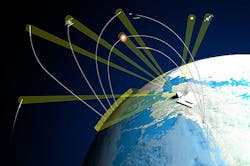Lockheed Martin nets big contract to build Long Range Discrimination Radar (LRDR)
Officials of the Missile Defense Agency (MDA) in Huntsville, Ala., announced a $784.3 million contract this week to the Lockheed Martin Mission Systems and Training segment in Moorestown, N.J., to develop, deploy, test, and operate a Long Range Discrimination Radar (LRDR) at Clear Air Force Station, Alaska.
The LRDR program is the backbone of the MDA's layered defense to protect the U.S. homeland from ballistic missile attack. It is a long-range radar that will provide precision metric data to improve ballistic defense discrimination and replace existing sensors in the Ballistic Missile Defense System (BMDS).
LRDR will keep pace with evolving ballistic missile threats and increase the effectiveness of ground based interceptors, Lockheed Martin officials say.
LRDR combines proven solid-state radar technologies with proven ballistic missile defense algorithms on an open-architecture designed for future growth. The solid state, gallium nitride (GaN)-based radar uses Lockheed Martin’s Open GaN Foundry model, which leverages relationships with strategic GaN suppliers, company officials say.
The LRDR will provide a persistent midcourse ballistic missile defense system (BMDS) discrimination capability as part of a layered defense of the U.S. from ballistic missile attacks of all ranges in all phases of flight.
The LRDR will serve as a BMDS midcourse sensor to counter evolving ballistic missile threats, as well as improve the ability to tell real ballistic missile warheads from decoys in any attack in the Pacific Ocean area.
MDA officials are asking Lockheed Martin to have the BMDS finished and operational no later than 2020.
As part of this contract, Lockheed Martin will conduct operating frequency band system tradeoffs. Company experts also will consider the relative benefits of limited field of view or full field of view for an aperture of a given radar sensitivity.
Company experts also will consider the potential scan loss that the terrain around Fairbanks, Alaska, imposes; the benefits and drawbacks of mechanical slewing in azimuth or azimuth-elevation; polarization selection and its potential effects on cost and sensitivity; resistance to electronic warfare (EW) jamming; opportunities to reduce power consumption; software and hardware reuse; and open-systems non-proprietary software architectures.
Lockheed Martin also will investigate issues related to graceful processor re-hosting, such as modular, loosely coupled software design, with documented interfaces that facilitate LRDR sustainment efforts.
On this contract Lockheed Martin will do the work in Moorestown, N.J., and at Clear Air Force Station, Alaska, and should be finished by January 2024.
For more information contact Lockheed Martin Mission Systems and Training online at www.lockheedmartin.com/us/mst, or the Missile Defense Agency at www.mda.mil.
